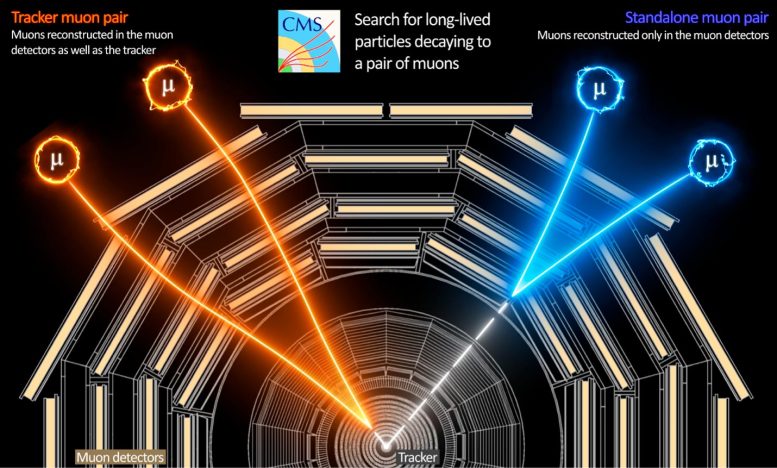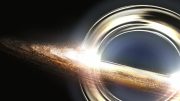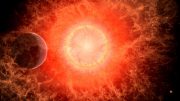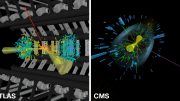
Illustration of two types of long-lived particles decaying into a pair of muons, showing how the signals of the muons can be traced back to the long-lived particle decay point using data from the tracker and muon detectors. Credit: CMS/CERN
This search for exotic long-lived particles looks at the possibility of “dark photon” production, which would occur when a Higgs boson decays into muons displaced in the detector.
The CMS experiment has presented its first search for new physics using data from Run 3 of the Large Hadron Collider. The new study looks at the possibility of “dark photon” production in the decay of Higgs bosons in the detector. Dark photons are exotic long-lived particles: “long-lived” because they have an average lifetime of more than a tenth of a billionth of a second – a very long lifetime in terms of particles produced in the LHC – and “exotic” because they are not part of the Standard Model of particle physics.
The Standard Model is the leading theory of the fundamental building blocks of the Universe, but many physics questions remain unanswered, and so searches for phenomena beyond the Standard Model continue. CMS’s new result defines more constrained limits on the parameters of the decay of Higgs bosons to dark photons, further narrowing down the area in which physicists can search for them.
Dark Photon Theory and Particle Detection
In theory, dark photons would travel a measurable distance in the CMS detector before they decay into “displaced muons.” If scientists were to retrace the tracks of these muons, they would find that they don’t reach all the way to the collision point, because the tracks come from a particle that has already moved some distance away, without any trace.
Run 3 of the LHC began in July 2022 and has a higher instantaneous luminosity than previous LHC runs, meaning there are more collisions happening at any one moment for researchers to analyze. The LHC produces tens of millions of collisions every second, but only a few thousand of them can be stored, as recording every collision would quickly consume all the available data storage. This is why CMS is equipped with a real-time data selection algorithm called the trigger, which decides whether or not a given collision is interesting. Therefore, it is not only a higher volume of data that could help to reveal evidence of the dark photon, but also the way in which the trigger system is fine-tuned to look for specific phenomena.
Advancements in Trigger System and Data Collection
“We have really improved our ability to trigger on displaced muons,” says Juliette Alimena from the CMS experiment. “This allows us to collect much more events than before with muons that are displaced from the collision point by distances from a few hundred micrometers to several meters. Thanks to these improvements, if dark photons exist, CMS is now much more likely to find them.”
The CMS trigger system has been crucial to this search, and was especially refined between Runs 2 and 3 to search for exotic long-lived particles. As a result, the collaboration has been able to use the LHC more efficiently, obtaining a strong result using just a third of the amount of data as previous searches. To do this, the CMS team refined the trigger system by adding a new algorithm called a non-pointing muon algorithm. This improvement meant that even with just four to five months of data from Run 3 in 2022, more displaced-muon events were recorded than in the much larger 2016–18 Run 2 dataset. The new coverage of the triggers vastly increases the momentum ranges of the muons that are picked up, allowing the team to explore new regions where long-lived particles may be hiding.
Future Plans and Continued Exploration
The CMS team will continue using the most powerful techniques to analyze all data taken in the remaining years of Run 3 operations, with the aim of further exploring physics beyond the Standard Model.









Was this written by AI, as it uses a lot of words to provide very little insight.
What was observed in the experiment can never be the world before the collision occurred. According to topological vortex gravitational field theory, the world before observation and collision can only be understood in mathematical models.
Dark photon structure 101: imagine a regular photon as a single linear sine wavelet. Divide this wavelet into its regular four quadrants. As a wave, each quadrants represents a specific variation of a “variable” above and below a baseline. Without going into details about this variable, this construction is compliant with causality, and it behaves as our regular photon. With a Dark Photon, the quadrants placement is not causally compliant, and it is not/not going anywhere. All that is left for this Dark Photon to do, is curl up as a ring, and then snap open and then fly away as your regular linear photon does i.e. with quadrants variations matching the causality … as dictated by the properties of the “variable”. This “conversion” process must take a certain amount of time …that can be calculated, detected…
What? You seem to have absolutely no understanding of what a photon is, let alone the hypothetical dark photon. You are just babbling nonsense.
What is appalling is that physics does not know what the universe is made of. Really! A Universe that existed and evolved for 13.8 BYrs requires something lasting that long (like a process) and a cause for it to happen. Nothing like energy, mass etc. or any experience we have. Physics uses matrices that can provide the right answer for any logically driven system. But matrices are just cheat sheet giving the right answer but no information whatsoever about the process at hand. The empirical approach is blind to the subject matter. Sorry! The FUTUR cannot come from the empirical approach alone. We need metaphysics to find out and know what (stuff) we are really talking about, that is out there! The answer is simple. A logically driven system (as understood by the use of matrices) requires a monism for its operation: One type of stuff, one type of cause. And GR …. gives it away!
Get help. Schizophrenia can be controlled through medication.
“We have really improved our ability to trigger on displaced muons,” says Juliette Alimena from the CMS experiment. “This allows us to collect much more events than before with muons that are displaced from the collision point by distances from a few hundred micrometers to several meters.”
No reason to duck, then.
Someone kindly explained to me it’s called a “Lorentz boost” that allows reaction points to be shifted.
I see the science funding fraud team is confidently ruling the web-roost in their tiny chicken heads. Calling the TheHeck a psycho last week right after he pretended to compliment me has really sharpened his religious wit.
Short list of jackass names I can never remember who appear to use sockpuppets and enjoy insulting people before asking questions:
1.) He’s here on this page! God’s gift to himself!
2.) The authoritarian GR-defender clown with the scary-stupid dark matter panther icon and a perverse need to do cutesy-pie things like stereotypically pretending to see a need to set the record straight on angular metrics not being distance metrics. Because, you know, Einstein can’t be wrong, little Thorbjoresson undertook from an early age to punish bent rainbow gravity-time heretics, with full approval from his parents, teachers, numerous religious guides, and his chess coach also pushing a radio transceiver thingy on the side.
The top poster says it all by asking if the research is written by AI since it “uses a lot of words to provide very little insight.” What is scarier? Those who gamble with the sacred earth and call it “exotic,” or artificial intelligence that has no regard for the value of life. I have been spoken to by higher beings who warned about the dire danger of those perpetrating deadly atomic research who have not even repented for the war crime atrocities of WWII. Now is the time to use your authority and insight to stop the wanton waste of $100 billion useless research before higher beings show up and demand an answer for deadly research that has no value to humanity while people suffer and die of poverty. You cannot gamble with our planet which is also theirs with useless research that resulted in horrifying weapons of human suffering. You stop this wanton waste and show that you value life, peace, and care about this sacred oasis and suffering humanity. I AM just a messenger, but they mean business.